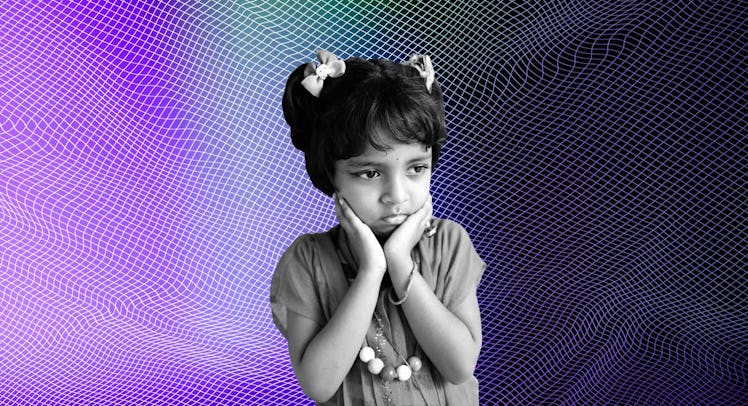How to Recognize Depression in Kids
Even very young children can experience depression, but parents have tools to recognize the symptoms

Signs of depression in children can easily go undiagnosed. For one, the signs of depression in children can be subtle, putting the onus of recognition on parents who may be distracted with already overwhelming lives. Second, some adults misunderstand depression as an adult condition brought on by the pressures and stressors of the world to which young children seem largely immune. But childhood depression is real and diagnosis requires keen observation. Luckily, if parents know what to look for, they can recognize the signs of depression in children early enough to manage symptoms with a therapist or other professional guidance.
Know Your Own Emotional State
Importantly, because depression is an internal state marked by feelings of hopelessness and helplessness, it’s unlikely that young children will have the emotional or developmental skills to communicate that they are depressed. So children themselves aren’t necessarily the best place to start when looking for information on their emotional state. In fact, parents are more likely to be successful in diagnosing depression — or any number of psychological conditions like anxiety or aggression — by looking to their own mental health first.
“The emotional state of a very young child is very tied up in the parents,” explains Dr. Abigail Gewirtz, a professor at the University of Minnesota’s College of Education and Human Development and author of When the World Feels Like a Scary Place: Essential Conversations for Anxious Parents and Worried Kids. “The first thing I tell parents is to pay attention to their own emotions first.”
Gewirtz acknowledges that it can be extraordinarily difficult for parents to observe their own emotional and psychological state independent of their children. The way a parent feels about the world, whether it be anxious or depressed, colors their experience. So, a parent who is overwhelmed by negative emotions will likely view their children’s behavior as negative regardless of how they are really behaving.
These emotional filters can also create feedback loops of negativity. Children of parents experiencing postpartum depression, for instance, often display symptoms of anxiety and depression themselves — not because the symptoms are contagious, but because depression can result in parental behavior that causes kids to feel destabilized.
Know the Signs of Depression in Children
So, from the outset, recognizing depression in children requires parents to make an honest appraisal of their own emotional state. From there, a parent can determine if what they see in their child’s behavior is an artifact of parental perception or influenced by parental behavior.
Once a baseline is set, parents should look for changes in child behavior that could be a sign of depression, Gewirtz says. “Look at differences in the way they are functioning. Look for a child who’s irritated or sad and withdrawn, particularly if being sad and withdrawn disrupts an activity that they used to be able to do,” she says.
For example, if a child can walk, they should be using that ability to explore their surroundings. But a depressed child may feel too sad and lethargic to walk and explore. Similarly, depression might cause a child who once slept well to become a poor sleeper or cause an active and gregarious child to become listless and sleepy.
“It’s important to note that these changes have to present themselves most of the time for more than two weeks,” Gewirtz notes. “And it has to occur across activities and relationships, so not just something that happens with mom or dad. It has to be generalized.”
Older children experiencing depression may also display behavioral changes. School-age children experiencing depression may suddenly seek to avoid playing with friends or going to school. They may seek to stay isolated indoors instead of being active and social, or stop playing sports that were once pleasurable.
Practice Emotion Coaching
That said, parents have an advantage in sussing out the signs of depression in older children because as long as they have the necessary words, older kids can start communicating about feelings. That’s why it’s important for parents to help children develop an emotional vocabulary through emotion coaching, according to Gewirtz. And when children are young, emotional swings and outbursts can offer really good opportunities to help them develop the language they need to talk about feelings.
First, parents can mark the emotional shift by naming it: “Oh, you look sad.” Then parents can describe how sadness feels: “When I feel sad, sometimes my tummy gets upset and I frown and want to cry.” Finally, parents can ask for confirmation: “Is that how you feel?”
Gewirtz stresses that all of this work isn’t necessarily easy and parents need to be forgiving of themselves. “Parents often blame themselves when they don’t notice these issues, particularly as kids get older,” she says. “But sometimes kids are really good at pretending.”
And, if parents are worried about depression, they should not hesitate to speak to a pediatrician or child psychologist. The signs of depression in children may not be easy to pick up and depression itself is difficult. But it can be managed. And with compassion, guidance, and therapy, children who feel depressed are not doomed to grow to be depressed adults.
This article was originally published on